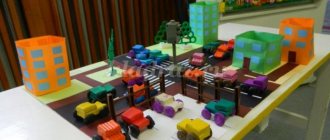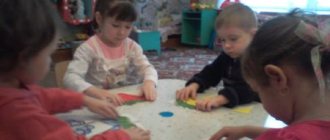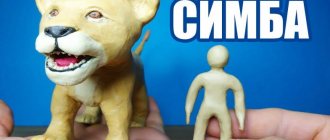Middle group. Junior preschool age. Children 4 - 5 years old
Summary of an OOD on modeling for children of the middle group on the topic “Bird” Summary of a lesson in modeling for children of the middle group on the topic “Bird”
Program content. Teach children to sculpt a bird from plasticine, convey the oval shape of the body, pull out and pinch small parts: beak, tail, wings, teach them to note the diversity of the resulting...
Summary of the modeling lesson “Make whatever toy animal you want” in the middle group Goal: to consolidate the ability to sculpt a toy animal from plasticine. Objectives: Educational: teach children to independently determine the content of their work; consolidate the ability to sculpt using different sculpting . Developmental: develop imagination, the ability to talk about what has been created...
Modeling. All modeling materials - Modeling “Tea set for dolls” for the middle group
Publication “Modeling “Tea set for dolls” for middle-aged...”
Objectives: Teach children to sculpt dishes. Develop fine motor skills. Develop collaboration and co-creation skills. Preliminary work: Examination of objects from a doll tea set. Materials, tools, equipment: Plasticine (teacher’s choice, stacks, caps...
Summary of a modeling lesson in the middle group “Magic Plasticine” Summary of a modeling lesson in the middle group on the topic “Magic Plasticine” Objectives: - to arouse children’s interest in molded material, teach how to work with it correctly - learn to determine the content of their work - teach them to use familiar ones techniques in modeling - to develop the ability to choose...
Individual modeling work with a 4-year-old child on the topic “Urban transport”
Modeling of special vehicles (taxi, ambulance, police car, fire truck) from plasticine dough. Program content: Reinforce sculpting techniques: rolling between palms (ball, long sausage) and use new techniques: pressing, smoothing, leveling...
Organization of continuous educational activities in sculpting for children in the middle group Goal: to consolidate the ability to create the image of a squirrel when sculpting, conveying the characteristic features of the animal’s body. To develop the child’s artistic and aesthetic perception through the means of fiction. (Work by S.Ya. Marshak “Mustachioed-striped kitten” Develop...
PERSPECTIVE PLANS IN THE MIDDLE GROUP LEPKA
Perspective plan for modeling and appliqué in the middle group.
Modeling 1
"Cheburashka"
Improve your ability to sculpt from plasticine. Teach children to pinch off small pieces of plasticine, flatten balls, and roll small peas. Nurture thinking.
Complex classes in the middle group Page. 45
Plasticine, board.
Application 2
"Beautiful flags"
Teach children to work with scissors: hold them correctly, squeeze and unclench the rings, cut a strip along the narrow side into equal pieces - flags. Reinforce techniques for careful gluing and the ability to alternate images by color. Develop a sense of rhythm and a sense of color. Evoke a positive emotional response to the images created.
Komarova T. S. “Art activities in kindergarten: Middle group” Pp. 29
Modeling 3
"Apples and Peaches"
Strengthen children's skills in sculpting round objects of different sizes. Learn to convey impressions of the environment in sculpting. Strengthen children's knowledge about fruits. Cultivate a positive attitude towards the results of your activities, a friendly attitude towards the works created by peers.
Komarova T. S. “Art activities in kindergarten: Middle group” Pp. 27
Plasticine, board, stack.
Application 4
"Vegetables on a plate"
Teach children to arrange objects in a pattern. Continue to introduce children to use scissors, cut vegetables from a square or rectangle, smoothly cut corners, turning the part. Cultivate accuracy in work.
Complex classes in the middle group Page. 66
Colored paper in red, orange, green, sheets of white paper in the shape of a plate, glue, scissors.
October
Modeling 1
"Cucumber and beets"
Introduce children to the techniques of sculpting oval-shaped objects. Learn to convey the features of each object. Strengthen the ability to roll clay with straight hand movements when sculpting oval-shaped objects and circular ones - when sculpting round-shaped objects. Learn to pull with your fingers, round the ends, smooth the surface.
Komarova T. S. “Art activities in kindergarten: Middle group” Pp. thirty
Cucumber, beetroot. Clay (plasticine, modeling boards.
Application 2
"Flower Bed"
Teach children to make a flower from 2-3 paper forms, beautifully combining them in color, shape and size. Show techniques for decorating a flower: cut the “shore” (edge) with a fringe, turning the paper circle in your hand: glue the smaller shape onto the larger one, applying glue to the middle of the base flower. Arouse interest in the design of a collective flower bed or clearing. Foster independence and accuracy.
Lykova I. A. Visual activities in kindergarten. page 24
Modeling 3
"Cockerel cockerel, golden comb"
Teach children to create an expressive image of a cockerel from plasticine and natural materials; show options for combining artistic materials: a body with a head made of plasticine, a tail and wings made of natural material and vice versa. Develop the ability to shape a composition. Arouse interest in experimentation in artistic creativity.
Lykova I. A. Visual activities in kindergarten. Page 32
Application 4
“The train is rushing “Knock-knock-knock”
Teach children to hold scissors and cut in a straight line: cut a paper rectangle into narrow strips. Arouse interest in creating a “railroad” from cut-up strips. Introduce safety rules when working with scissors. Develop coordination in the work of eyes and hands. Cultivate accuracy and interest in mastering the instrument.
Lykova I. A. Visual activities in kindergarten. Page 22
November
Modeling 1
By design
Teach children to determine the content of their work and use familiar techniques in modeling. Develop the ability to select the most interesting works from those created. Develop children's imagination and creativity.
T. S. Komarova “Classes in visual arts” p. 32
Clay, boards for modeling.
Application 2
"Teddy bear"
Teach children to assemble a familiar toy from parts, gluing them in the specified sequence; transmit paw movement.
G. S. Shvaiko “Classes in visual arts in kindergarten, middle grade.” page 24 Blanks for a bear.
Modeling 3
"Modeling vegetables"
Introduce children to the technique of pressing the middle of a ball and smoothing the surface of a sculpted object with your fingers.
Complex classes in the middle group Page. 65
Plasticine.
Application 4
"Decorate the napkin"
Teach children to make a pattern on a square, filling in the middle and corners with elements. Learn to cut a strip in half after folding it; hold scissors correctly and use them correctly. Develop a sense of composition. Strengthen the ability to carefully glue parts.
T. S. Komarova “Classes in visual arts” p. 34
Square sheet 16x16 cm. Strips of different colors 6x3 cm, scissors, glue, napkins, oilcloth, brush.
Modeling 4
“Make whatever toy animal you want.”
Teach children to independently determine the content of their work. Strengthen the ability to sculpt using different sculpting techniques. Foster independence. Develop imagination.
T. S. Komarova “Classes in visual arts” p. 57
Clay (plasticine, modeling board, stack.
December
Application 1
"Bullfinch"
To consolidate children's knowledge about migratory and wintering birds. Develop the ability to examine and examine objects. Continue to develop the ability to arrange parts on a sheet in a certain order. Strengthen your neat gluing skills.
Modeling 2
"Girl in Winter Clothes"
To evoke in children a desire to convey the image of a girl in a sculpted image. Learn to identify parts of the human figure in clothing (head, fur coat of the arms that widens downward), and convey them in compliance with proportions.
T. S. Komarova “Classes in visual arts” p. 51
Doll. Clay (plasticine, modeling boards
Application 3
"Beads for the Christmas tree"
Learn to cut corners of rectangles and squares to obtain oval and round beads; Alternating beads of different shapes; stick carefully, evenly, in the middle of the sheet. To consolidate children's knowledge about round and oval shapes. Continue to teach children safety precautions when working with scissors, instill a festive mood and a desire to decorate the Christmas tree.
T. S. Komarova “Lessons in visual arts” p. 53 Beads, paper rectangles and squares of different colors, thread, glue, brush, napkin, scissors.
January
Application 1
“Beautiful pyramids were brought to the store.”
Exercise children in cutting out rounded shapes from squares (rectangles) by smoothly rounding the corners. Reinforce scissor handling techniques. Learn to select colors and develop color perception. Exercise children in arranging figures by size in decreasing order.
T. S. Komarova Visual activities in kindergarten. Page 56
Paper squares of different colors and sizes, 1\2 album. sheets, scissors, glue.
Modeling 2
"Snowy Baba"
Continue to teach children to create expressive sculpted images. Learn to plan your work: conceive an image, divide the material into the required number of parts of different sizes, sculpt sequentially, starting with large parts. Show techniques for decorating a sculpted figurine with additional materials. Develop an eye, a sense of shape and proportions.
I. A. Lykova Visual activities in kindergarten. page 76
Application 3
"Snowman"
Teach children to carefully cut out parts, assemble them together according to a pattern, and glue them evenly. Use scissors according to instructions.
Complex classes middle group p. 178
Colored and white paper, glue, scissors, napkins.
Modeling 4
“Come and visit.” (Sparrows on the feeder).
Teach children to convey a simple pose in sculpting: tilting the head and body down. Reinforce sculpting techniques. Show the possibility of obtaining a more expressive color by mixing two original colors. Develop a sense of form and composition ability.
T. S. Komarova Visual activities in kindergarten. Page 65
Plasticine, modeling board, stack.
February
Application 1
"Flying Planes"
Teach children to correctly compose images from parts, find the place of one or another part in the overall work, and carefully stick it on. Consolidate knowledge of the shape (rectangle, learn smoothly, cut off its corners. Cause joy.
T. S. Komarova Visual activities in kindergarten. Page 64
Paper rectangles for the body, tail and wings, scissors, glue, brush, napkin.
Modeling 2
"Funny Helicopters"
Teach children to sculpt air transport (helicopter). Pay attention to the methods of attaching parts (smearing, using toothpicks or straws). Clarify your understanding of the structure and method of movement of a helicopter. Create a desire to please dads with your crafts.
I. A. Lykova Visual activities in kindergarten. page 96
Application 3
Decorative applique on a square
Teach children to make a pattern on a square, rhythmically placing geometric shapes in the corners, in the middle, along the edges. Learn to transform shapes by cutting them (a square into 2 triangles, a rectangle into 2 squares). Reinforce cutting techniques. Foster independence.
T. S. Komarova Visual activities in kindergarten. Page 69
White paper 18x18cm, strips of colored paper, scissors, glue, brush, napkin.
Modeling 4
"Flowers-hearts"
Teach children to sculpt relief paintings as gifts for loved ones - mothers and grandmothers. Show options for depicting flowers with elements - hearts. Learn to sculpt hearts in different ways: model with your fingers; cut with a mold or stack. Arouse interest in framing stucco paintings. P-r – develop a sense of form and rhythm. Cultivate aesthetic taste.
I. A. Lykova Visual activities in kindergarten. page 104
March
Application 1
"Owlet"
Teach children to make an object from parts, carefully cut out parts of the applique, from a circle - a body, two semicircles - wings, a small triangle - a beak, two small circles - eyes, two triangles - ears, two triangles - paws.
Complex classes Page 247
Colored paper, glue, scissors.
Modeling 2
"Make what you like"
To develop children’s ability to evaluate their impressions and determine their attitude to what they saw. Strengthen the desire to create interesting images in sculpting, using previously learned techniques.
T. S. Komarova Visual activities in kindergarten. Page 75
Clay, modeling board, stack.
Application 3
"Icicles on the roof."
Arouse interest in depicting icicles using different applicative techniques and creating the composition “Icicles on the roof of a house.” Continue to learn how to cut with scissors and independently adjust the length of the cuts. Show how to cut out icicles from paper folded like an accordion. Develop a sense of shape, color, rhythm.
I. A. Lykova Visual activities in kindergarten. page 116
Modeling 4
"Little Goat"
Teach children to sculpt a four-legged animal (oval body, head, legs). Strengthen sculpting techniques: rolling between palms, attaching parts to the sculpted body of an animal, smoothing places of fastening, pinching, etc. Develop sensorimotor experience.
T. S. Komarova Visual activities in kindergarten. Page 73
Clay, modeling board, stack.
April
Application 1
"Vitamin basket"
Teach children to arrange ready-made forms in the “Vitamin Basket” composition;
develop the ability to use glue, develop fine motor skills; to cultivate in children the need to consume healthy foods, a sense of empathy, and a desire to help.
“Basket for vitamin products”, blanks of vegetables and fruits made of colored paper, glue, napkins, individual oilcloths.
Modeling 2
"Rocket"
Develop interest in artistic creativity, consolidate concepts: outer space, weightlessness, gravity, planets, stars, satellites, meteor shower, comets, Martians, etc. Develop children's powers of observation, memory, and interest in the world around them. Teach children to show imagination and creative imagination. Continue work on developing verbal communication skills.
Plasticine, a board, napkins, a Kinder Surprise container.
Application 3
"Eternal flame"
Reinforce appliqué techniques in the trimming technique, consolidate knowledge of safety precautions with scissors. Develop fine motor skills, develop tactile sensations, develop imagination. Templates of the Eternal Flame, squares of corrugated colored paper (different colors, brush, pencil, napkin, oilcloth, scissors, glue.
Modeling 4
Modeling a ladybug from dough
Introduce children to work with dough, it is elastic. Convey the characteristic features of their structure. Develop thinking and attention. Complex classes p. 253
Salty dough black, red, green.
May
Application 1
"Spring Flower"
Teach children to cut using the technique of smoothly rounding the corners of a square, cut the circle in half along the fold; make up of parts - circles, semicircles and a narrow stripe - images of unblown and blossoming flowers; reinforce neat gluing techniques.
G. S. Shvaiko “Classes in visual arts in kindergarten, middle grade.” page 129
Material prepared by the teacher.
Modeling 2
"Modeling by design"
Continue to develop independence, imagination, creativity. Strengthen sculpting techniques and the ability to use materials carefully.
T. S. Komarova Visual activities in kindergarten. Page 67
Plasticine, modeling board, stack.
Application 3
Little Red Riding Hood"
Teach children to convey the image of a red riding hood in appliques. Continue to learn how to depict a person (the shape of a dress, head, arms, legs, characteristic details (a cap, observing the relationships in size. Strengthen the ability to carefully cut and paste.
T. S. Komarova Visual activities in kindergarten. Page 83
Colored paper, scissors, glue, brush, napkin, oilcloth.
Modeling 4
“How we played an outdoor game”
Continue to teach children to create images of outdoor play in modeling. Develop imagination and creativity. Reinforce sculpting techniques.
T. S. Komarova Visual activities in kindergarten. Page 86
Plasticine, modeling board, stack.
G. S. Shvaiko “Classes in visual arts in kindergarten, middle grade.” pp. 69-71
Application 5
Final “Magic Garden”
Teach children to create a collective composition, independently determining the content of the image (magic trees, flowers). Learn to cut straight with scissors; rounding the corners of a square, rectangle. Develop perception.
T. S. Komarova Visual activities in kindergarten. Page 85
Colored paper, gold and silver, large sheet, scissors, glue, brush, napkins, oilcloth.




